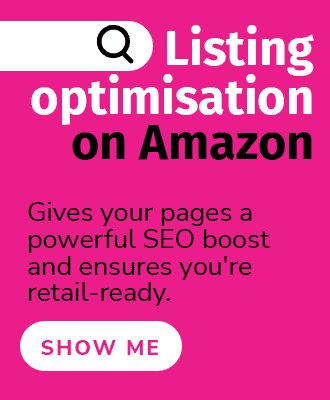What is RoAS and why does RoAS matter? Put simply, RoAS is an acronym for Return on Ad Spend. Amazon Advertising RoAS is an important metric to determine the performance of campaigns and keywords. Retailers (both Amazon sellers and Amazon vendors) can calculate RoAS to show income or loss on advertising campaigns and determine the cost-effectiveness of advertising strategy.
Why does RoAS matter?
Running sponsored ads PPC campaigns is a great way to boost your Amazon business. It can drive brand awareness, improve traffic and conversion on your listings, and increase your rankings. But for new businesses or new product launches, how do you know what amount is worth investing and how can you possibly measure success? Clicks and impressions may show if a campaign or keywords are getting traction and sales are certainly a good indicator of success, but to ensure you’re profiting from the money spent on advertising campaigns, businesses should look closely at RoAS.
When testing a variety of strategies, campaigns types, and keywords, RoAS values in Amazon Advertising can tell advertisers which marketing efforts are ineffective and which are working (or at least more effective). This then allows advertisers to adjust bids or investments accordingly and, in turn, increase revenue while making sure the ad spend or budget is sustainable.
How to calculate RoAS?
There is a formula for calculating RoAS that is relatively simple.
RoAS = Total Attributed Sales / Total Ad Spend
RoAS = 1/ACoS
RoAS equals the total attributed sales divided by the total ad spend. For example, if a business spends $1000 on a campaign and earns $5000 in sales from the ad, the calculated RoAS would be 5.
If a campaign has a RoAS of 5, that means for every $1 spent on the ad, the campaign made $5, or a RoAS of 5. The more profit the campaign makes overall, the higher the RoAS value will be.
What is a good RoAS on Amazon?
Advertisers also need to remember that other costs are not included in the RoAS calculation, such as initial product costs, delivery, Amazon fees, PPC tool fees, design, content writing, etc. RoAS simply measures the spend on the particular ad within the Amazon Advertising platform.
A benchmark of RoAS of 4 is the approximate industry average. But a “good” RoAS on Amazon will depend on the business and the product’s margin. For example, a product priced at $600 is likely going to take a lot more clicks (which ads up when ads are pay-per-click) to convert a sale. A product priced at $25 may only take a few clicks because customers are more likely to buy a lower-priced item. That said, a small profit margin will need a higher RoAS to be profitable, whereas a large profit margin will have the ability to achieve profitability with lower RoAS.
This is where retail readiness and proper Amazon strategy will be necessary to determine what items to sell on Amazon and how to market them most effectively.
For any product, it’s also important to know the exact amount where the business breaks even for the particular product before advertising costs are introduced, as this will allow you to know your baseline or minimum RoAS. This is part of a larger calculation. The break-even point is what you make from your sale after the cost of goods sold (CoGS) are totalled. CoGS will include all expenditures, everything from the cost of manufacturing and shipping, Amazon FBA charges, storage and logistics costs, labels, professional services, etc. This number shows gross profit before you take advertising into account.
If you know the total CoGS (including Amazon fees) for a product are $15 and you list it at $25, the profit before advertising is $10. If you have to spend $10 to make one sale, you’ve broken even and made no profit.
Once you know the number at which you break-even, you can find the minimum RoAS and know what ad spend still allows you to be profitable. To calculate this, take the sale price and divide it by the break-even number to find your minimum RoAS. In the example above, the price is $25 and the break-even point is $10. That means the minimum RoAS is 2.5.
From this example, it should be clear that what works for one item may not work for another. What is profitable for one seller or vendor may not be for another. Likewise, some businesses might be able to support a lower RoAS if the goal is different, for instance, if they are merely focused on brand recognition in a niche. Or if the goal is to clear out overstocks which are costing the business in other ways, or perhaps to drive traffic to a new Brand Store, and on and on. Also, what works well for a particular brand, product, or even time of year, may not be effective in other circumstances.
What types of ads campaigns have the best RoAS?
Different categories and types of ads will also yield different RoAS numbers. In general, Sponsored Brands campaigns tend to yield the highest RoAS, with Sponsored Display yielding a lower average RoAS. To fully utilise Sponsored Brands, businesses must be Brand Registry approved.
How to find your RoAS

Navigate to the Amazon Advertising platform and sign in. On the left side is a “Sponsored ads” tab. Clicking on this will open a dashboard that shows totals from all of your sponsored ads at the top, including the average RoAS for all campaigns. From there, brands can drill down into a certain time period. They can also filter or sort by RoAS, and a number of other metrics, like clicks, sales, etc.
More help with Amazon Advertising
This blog gives some basic insight into how RoAS can be calculated and how knowing your RoAS can help your business. There is not one single RoAS target that will be ideal for all businesses. We hope this information helps assist in calculating a profitable RoAS for your particular business and situation. eCommerce Nurse is a full-service agency specialising in Amazon. We offer Amazon Advertising support as part of our core services. If you need more assistance or strategy planning on RoAS, campaign optimisation, or marketing support, please contact us.




